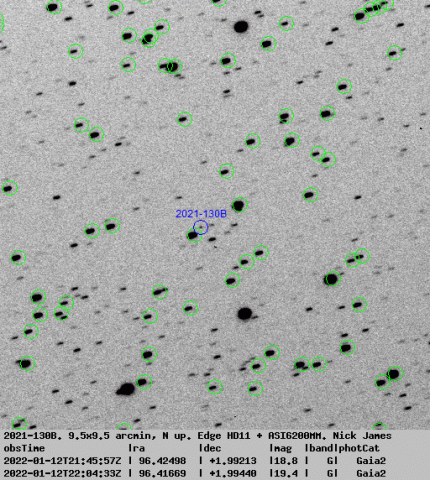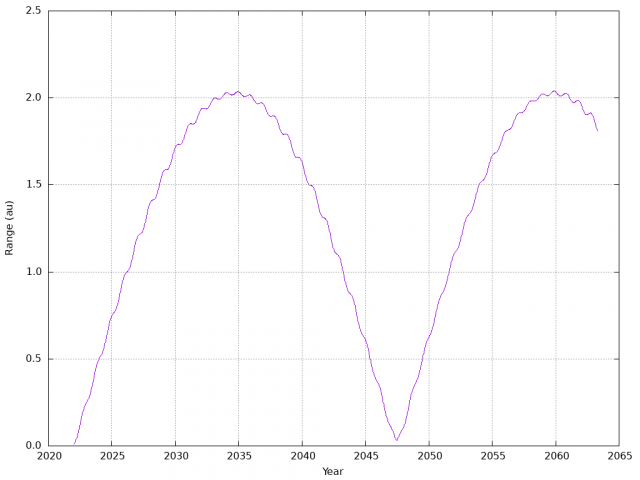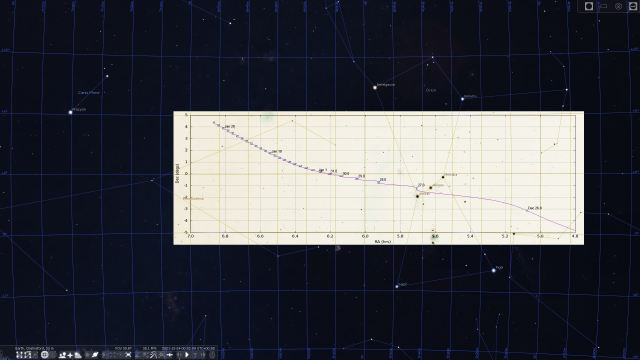Forum Replies Created
-
AuthorPosts
-
 Nick JamesParticipant
Nick JamesParticipantPhil – That is a really interesting observation.
I assume at the moment the spacecraft attitude will be quite stable. I don’t know whether the solar array can be steered to some extent relative to the bus but for now I would guess that they are keeping the spacecraft sun-pointing although I don’t know that for sure. If that is so then the brightness variations will be due to the phase angle (i.e. sun, spacecraft, observer). The repeatability here implies a diurnal variation. At the current range (about 1.2 million km) the Earth has an apparent diameter of 0.6 degrees so the effect of parallax on the phase angle is very small although certainly large enough to affect the timing of specular glints depending on where you are.
It would be very interesting to get two observers separated by a long baseline to do photometry at the same time. I suspect that they would see quite different profiles.
Once JWST goes operational the spacecraft attitude will be continually changing depending on the target so these glints will become much more (apparently) random.
 Nick JamesParticipant
Nick JamesParticipantI know some people are still attempting to image both objects. The ephemerides available from Project Pluto are still good but the magnitude of the upper stage was quite faint last time I imaged it on Jan 12.9. It is around mag 19 at the moment. The magnitude of JWST is highly variable depending on the precise orientation of the spacecraft.

 Nick JamesParticipant
Nick JamesParticipantThe entire deployment sequence seems to have gone without a hitch with both folding sides of the primary mirror now locked in place. That is pretty amazing given the complexity.
 Nick JamesParticipant
Nick JamesParticipantThat’s a really nice observation. If you look at images of JWST you can see that we are mainly seeing the 21x14m sunshield but there is other stuff on the sunward side of the spacecraft including the solar panel and the spacecraft bus and propulsion units. Some sunlight will be scattered back to us from these other components but there will be strong glints from the sunshield which will be highly dependent on the relative angle between the sun and the observer. Given JWST’s configuration even small changes in this angle will make a significant change to the magnitude we see.
When the telescope is operating at L2 it is in a large radius halo orbit and the attitude will change for each observation since the telescope and sunshade are fixed to each other. It will be an interesting project to try to predict when glints would occur given the target list that the telescope will be aimed at.
 Nick JamesParticipant
Nick JamesParticipantYes, it looks to be 787 (Moskva). Well done spotting it. As you’ve confirmed you got JWST as well.
 Nick JamesParticipant
Nick JamesParticipantHi Mel,
I’ve looked at your YT video and haven’t been able to ID the field yet and have to rush off to work now. I’ll have another look when I get in tonight. To help confirm that you have got JWST I attach an image I took just at the start of your set (Jan 4 at 22:29). The trail of JWST is marked. The upper stage is around 3 magnitudes fainter than JWST and around 2.5 degrees west of it so your other object is not the upper stage. I can probably identify it if you let me have an accurate position.
You can get an accurate ephemeris of both JWST and the upper stage from here:
https://projectpluto.com/sat_eph.htm
This is based on amateur astrometry of both objects and is pretty well up to date.
 Nick JamesParticipant
Nick JamesParticipantNice image David. As of tonight (Jan 2) with the sunshield fully deployed but not yet tensioned JWST was mag 14.5 at a range of 800,000km. When it gets to L2 it will be twice as far away (1.5 million km) so probably around mag 16 although this will strongly depend on the solar aspect angle. That is 4-5 magnitudes brighter than Gaia.
The Ariane upper stage was magnitude 17.4 tonight at 890,000km. At this rate it will drop below mag 20 in early February when its range exceeds 2.5 million km.
 Nick JamesParticipant
Nick JamesParticipantGrant, The upper stage was 16.5 last night. It will be passive now so optical astrometry is useful to determine where it is going. JWST will be injected into a halo orbit around L2 and will require periodic station keeping to keep it there. Since L2 is unstable the upper stage will move off into a heliocentric orbit with a period of around 380 days. Using astrometry from Peter Carson and myself I’ve integrated this forward and it is likely to return to the Earth’s vicinity in the summer of 2047 when it will be around mag 20 (see plot attached). The more accurately we can get astrometry as it departs the better we can predict where it will be in 2047 so surveys in 25 years time will know what it is.

 Nick JamesParticipant
Nick JamesParticipantI got images of the JWST spacecraft (2021-130A) and the Ariane upper stage (2021-130B) last night. They are currently around 2 degrees apart on the sky. JWST is much brighter tonight as the sunshield was being deployed. The magnitude was 14.3 at a range of 687,000 km. From the timings in the NASA blog I think that the sunshield was half out when this image was taken but this implies a magnitude of around 16 or so at L2. Astrometry of the upper stage is valuable since it is not being tracked by radio and I assume it is now passive.
 Nick JamesParticipant
Nick JamesParticipantDavid – well done. Still no opportunities for me! It looks as if the complex deployment is going very well (https://blogs.nasa.gov/webb/).
 Nick JamesParticipant
Nick JamesParticipantDenis managed to get another image of the spacecraft last night at around mag 14.5. I’ve had no luck since the weather has been cloudy here and all of the iTelescope systems that I have tried to use have had “roof closed” even when the all-sky camera showed clear sky.
The Horizons ephemeris is good for the spacecraft. There has been quite a bit of amateur astrometry of the upper stage and you can get an ephemeris of that from Bill Gray’s artsat ephemeris page here.
 Nick JamesParticipant
Nick JamesParticipantDenis Buczynski (Tarbatness) managed to get the spacecraft tonight at mag 12.3 which is a bit fainter than I expected. Luca Buzzi reports via MPML that the upper stage is around the same magnitude and about half a degree west of the spacecraft. There will probably be a significant effect on the magnitude when the sunshade gets deployed. Total washout here.
 Nick JamesParticipant
Nick JamesParticipantIt was great to see the solar array deployment live via the upper stage camera. The launch certainly added some excitement to Christmas lunch and the Ariane 5 performed very well. Now, if only we could get a clear patch between the torrential rain…
 Nick JamesParticipant
Nick JamesParticipantHere is a revised chart for the current Dec 25 launch. You can see that it follows pretty much the same path, shifted around 4 minutes east a day.

 Nick JamesParticipant
Nick JamesParticipantMost likely you have a start time set before the launch time. The last line of all those error messages is:
No ephemeris for target “James Webb Space Telescope (spacecraft)” prior to A.D. 2021-DEC-25 12:48:00.0000 UT
 Nick JamesParticipant
Nick JamesParticipantSince the launch window opens at about the same solar time every day the chart should remain valid by just offsetting the dates, so, for instance, if it does go up on Christmas day then substitute 27.0 for 26.0 and so on. There will be an eastward drift of 4 mins a day in RA as well. In any case the JPL Horizons ephemeris will be updated to reflect the actual launch time.
 Nick JamesParticipant
Nick JamesParticipantIt is very well placed for us and everyone but that is not entirely a coincidence. It is going in the anti-solar direction and the launch is scheduled to avoid getting too close to the Moon. Winter is definitely good for us in the northern hemisphere since L2 is currently high in the sky.
There’s not much detail available about what will happen to the cryogenic upper stage following JWST separation which occurs at around 30 minutes after launch. JWST is directly injected into a transfer orbit to L2 so the upper stage will probably be close by but it will probably do some form of deflection burn and JWST itself will do its first course correction at L+12.5h so the two will drift apart. There is another course correction burn scheduled for L+60h. I don’t know how bright the upper stage will be but on the first few nights I would expect it would be detectable and fairly close to the spacecraft. I’ve imaged Centaur upper stages at ranges of more than 700,000 km and the Falcon 9 upper stage at 400,000km but the Ariane upper stage is smaller I think. The Centaurs also do propellant dumps which can be interesting to watch. I assume that the Ariane stage does something similar.
 Nick JamesParticipant
Nick JamesParticipantJust for the record your attachment is a doctored version of the Time cover. The original is here. Whatever your views on Elon Musk you should have pointed that out. Twitter is not an ideal primary source for much.
 Nick JamesParticipant
Nick JamesParticipantThanks all for the positive Sky Notes comments. I do appreciate having the opportunity to show some of the excellent work that our members do.
Oddly enough I am seldom referred to as a gentleman…
 Nick JamesParticipant
Nick JamesParticipantThe JBAA is one of the few journals/periodicals that I continue to get as a physical thing. I’ve been a member of the BAA since 1974 and my run of Journals goes back getting on for 50 years (scary) but still only takes up a couple of metres of shelf space so storage isn’t really an issue. A bit like Jeremy I find that I don’t read digital copy in the same way as physical, its much more a quick scan then store it on the computer to look at another day. I tend to embrace new technology but reading for pleasure is still definitely physical books for me and I feel the same way about the Journal.
As Dominic says, you have access to the electronic Journal now so can try it and see how it works out.
-
AuthorPosts
